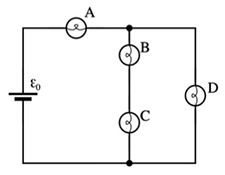
A model for circuits Part 2: Potential difference
Variant i Dynamics first
Voltage and Kirchhoff’s loop rule are introduced in the context of circuits. Emphasis is on making and testing predictions that elicit and confront student difficulties.
Topics Electricity and magnetism / Electric circuits: models, circuits, current, and electric potential difference
Materials
Materials by the UW team
- Instructor Guide


- Pretest


- Exam Questions



- Equipment List

Tutorial details
The first section of the tutorial is a review of current. The questions are intended to address to address any lingering incorrect beliefs, such as the idea that current is “used up” or that batteries are constant current sources. In the last exercise in this section, students predict the relative brightness of three bulbs in three different circuits. We have found it useful to ask students to identify which diagram corresponds to each real circuit before connecting the circuits to check their prediction.
In section II, students engage in hands-on experience using voltmeters to measure voltages in various simple circuits. They apply their knowledge of current and use their measurements to decide that bulb brightness is an indicator of the voltage across the bulb. Students are guided to realize that although the current through a battery depends on the circuit to which it is connected, the potential difference across the battery does not.
In the final section, students reflect upon their results and are guided to formulate Kirchoff's loop rule. At this point, students are asked to check their answers with a tutorial instructor. Students often need guidance in considering the possible errors in their voltage measurements. Some students are reluctant to conclude that the total potential difference across a loop is the same as the potential difference across the battery if their measurements are not exactly equal.
For instruction tips, login or register as a verified educator to see the Instructor Guide.
Prerequisites
Prerequisite tutorials
The A model for circuits Part 1: Current and resistance tutorial is a prerequisite to A model for circuits Part 2: Potential difference.
Other prerequisites
This tutorial assumes students have a model for electric current that they can use to relate bulb brightness to current. (See the tutorial A model for circuits Part 1: Current and resistance.) They are expected to recognize what is necessary to have a complete circuit, to recognize that current is not “used up” in an electric circuit, and to have had laboratory experience with batteries, resistance, and series and parallel circuits.
Equipment
Special Instructions
The batteries should be checked before tutorial to be sure that they are fresh. This is especially important for the circuit for part I.C.
Circuits for demonstration:

List
- battery
- battery holders (2)
- D-cell
- voltmeters (5-volt range)
- white board or large sheet of paper with markers
- bulbs (#14) in sockets
- ample connecting wire including some alligator clips
- set of circuits (see figure) - each with two D batteries and #14 bulbs (for demonstration)
Research
- L. McDermott and P. Shaffer, Research as a Guide for Curriculum Development: An Example from Introductory Electricity. Part I: Investigation of Student Understanding, Am. J. Phys. 60 (11), 994 (1992).
- P. Shaffer and L. McDermott, Research as a Guide for Curriculum Development: An Example from Introductory Electricity. Part II: Design of Instructional Strategies, Am. J. Phys. 60 (11), 1003 (1992).
Coming Soon! We hope to release the discussion section on each tutorial soon.

